
We are running on a fruit and vegetable deficit.
We know they're good for us — eating enough fruit and veggies is linked to a reduced risk of heart disease, diabetes, cancer and obesity — but yet, we're still failing to eat enough, according to the Centers for Disease Control.
Video of the Day
Video of the Day
Only 12 percent of adults meet the recommended fruit servings per day and even fewer, 9 percent, eat enough vegetables.
And we're not just missing the mark — we're falling way short. We should be eating nine or more servings of fruits and vegetables every day but we're only getting about 3.5 servings on average, according to a May 2013 study in Advances in Nutrition.
The key to eating more fruits and vegetables is finding different ways to eat them — and, often, this means thinking outside of the box and experimenting with new flavors.
"Adding herbs, spices and other seasonings to veggies and fruits is one of the simplest yet most creative ways to boost your produce intake," says Jackie Newgent, RDN, culinary nutritionist and author of The Clean & Simple Diabetes Cookbook. "Often, just a pinch can add the pizzazz you need to give new life to an otherwise plain preparation."
Don't settle for the same old salt, pepper and olive oil combo. (It's delicious, yes, but it can get real boring, real quick.)
Instead, literally spice things up by using new-to-you herbs and seasonings with your summer fruits and vegetables. Here are six ideas to get you started.
1. Tajin
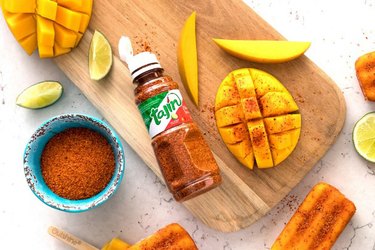
For many, Tajin isn't new. But if you have yet to try it, run don't walk to your nearest grocery store because you've been missing out.
"Tajin is a seasoning mixture based on red chilies, lime and sea salt," Newgent tells us.
"The spicy-tangy-salty trio can provide a pop of 'wow' to apples, mangos, pineapple, watermelon, corn, carrots, cucumber and jicama. You can simply sprinkle it onto a juicy watermelon wedge, grilled corn on the cob or oven-roasted carrots."
And, it doesn't just add flavor. "Chili peppers contain capsaicin, which provides their notable spiciness as well as potential anti-cancer properties," shares Newgent. While more research needs to be done, preliminary studies show that capsaicin holds promise in helping prevent heart disease and cancer, according to a June 2015 review in Open Heart.
Not fruit and vegetable-related but still worth the mention — "if you're a cocktail drinker, tajin creates an awesome flavored rim for a margarita," adds Newgent.
2. Mint
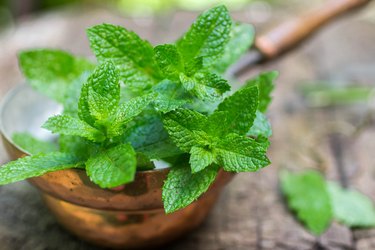
Fresh mint leaves are a secret weapon when it comes to fruits and vegetables.
"Mint is delicious when paired with both vegetables and fruits, especially beets, carrots, peas, cucumber, eggplant, potatoes, tomatoes, summer squash and all types of berries and melons," Newgent says. In other words, the sky's the limit.
If you're feeling tired, anxious or moody, spices and herbs like mint may help. An older July 2009 study published in the North American Journal of Psychology found that just smelling peppermint while driving increased awareness and decreased frustration, anxiety and fatigue.
This research builds on previous studies finding that peppermint stimulates our nervous system and increases motivation and performance.
Another simple but creative way to eat (and smell) more mint? "I love tossing fresh mint leaves into summery salads as an integral part of the salad greens, not just as a garnish," shares Newgent.
3. Cinnamon
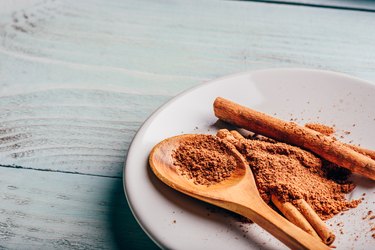
Cinnamon becomes exciting again when we use it in new and interesting ways.
"Cinnamon is a sweet spice with a hint of pungency that many people first associate with its culinary affinity for fruits, like apples, bananas and pears — think fresh-baked apple pie à la mode," Newgent says.
"But being the daughter of a Lebanese mother, I associate the spice mainly with savory Middle Eastern dishes. One of my favorite uses for cinnamon is in a classic stewed green bean and tomato dish called Loubieh. Cinnamon also works really well with eggplant and summer (and winter) squashes."
Cinnamon has been well-researched and may play a beneficial role in the management of metabolic syndrome, including the treatment of diabetes. A clinical trial in the Journal of Diabetes & Metabolic Disorders compared the effects cinnamon, probiotics, a synbiotic (cinnamon plus probiotic) and rice flour (placebo) had on fasting blood sugars.
Turns out, cinnamon, the synbiotic and probiotic all significantly decreased fasting blood sugars compared to the placebo.
4. Basil
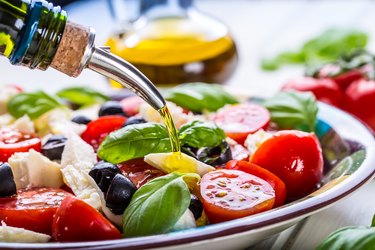
"Basil is best known for adding distinct Italian taste to meals, like in Caprese salad, but it's also delicious with bell peppers, eggplant and zucchini," shares Newgent.
"But perhaps the most interesting basil pairing is with peaches, mangos, berries and watermelon. For instance, try a watermelon-basil beverage or a cold soup. Or, swap peaches in place of tomatoes for a fruitier Caprese-inspired salad or grilled sandwich."
Aside from adding a fresh balance to sweeter fruit, the nutrients in basil are linked to helping with symptoms of depression.
A September 2018 paper in the Journal of Psychiatry outlined a nutrient profile scoring system for certain foods that may help fight depression.
Fresh herbs — specifically cilantro, basil and parsley — were some of the highest-ranking (i.e. most beneficial) foods, along with leafy greens like spinach, watercress, romaine and Swiss chard.
5. Cilantro
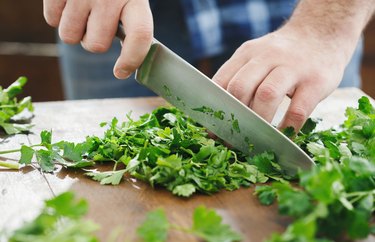
"I adore the pairing of fresh cilantro and its refreshing anise-like fragrance with mangos, tomatoes or avocado, especially for providing Mexican flair, like in pico de gallo (fresh chunky salsa)," Newgent says.
"Try an intriguing sweet-smoky version by brushing mango chunks with oil, grilling them and then dicing and combining them with fresh cilantro, red onion, jalapeno, lime juice and sea salt."
There are healthy reasons to add cilantro, too. In addition to its link to improving depression per the Journal of Psychiatry study, it may protect your brain in other ways, too, according to an April 2019 study in the Journal of Traditional and Complementary Medicine.
The review found that cilantro is tied to helping relieve anxiety and insomnia.
6. Black Pepper
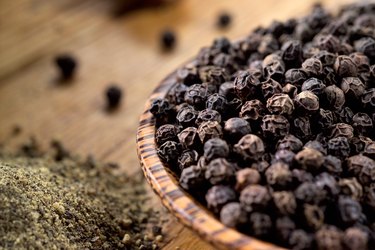
OK, we know we said to branch out, but hear us out. Freshly ground black pepper pairs super well with fruit — especially summer fruit.
"When I toss fresh or grilled strawberries into salads, I add plenty of black pepper, which adds a perfectly pungent balance for the fruity sweetness," shares Newgent. The spice also works well with pineapples, plums and peaches.
You can feel good about adding pepper (minus the salt) because it may benefit your health, too.
Adding black pepper when grilling (especially with meats), might help reduce the formation of cancer-related heterocyclic amines (HCAs), per Kansas State University.
So the next time you're grilling, sprinkle ground black pepper on everything — fruit, vegetables and meat — for added flavor and health benefits.
- Centers for Disease Control: "Disparities in State-Specific Adult Fruit and Vegetable Consumption — United States, 2015"
- Advances in Nutrition: "Health-Promoting Components of Fruits and Vegetables in the Diet"
- Open Heart: "Capsaicin May Have Important Potential for Promoting Vascular and Metabolic Health"
- North American Journal of Psychology: "Effects of Peppermint and Cinnamon Odor Administration on Simulated Driving Alertness, Mood and Workload"
- Journal of Diabetes & Metabolic Disorders: "Effects of Probiotic, Cinnamon, and Synbiotic Supplementation on Glycemic Control and Antioxidant Status in People with Type 2 Diabetes; a Randomized, Double-blind, Placebo-controlled Study"
- World Journal of Psychiatry: "Antidepressant Foods: An Evidence-based Nutrient Profiling System for Depression"
- Journal of Traditional and Complementary Medicine: "Neuroprotective Potency of Some spice Herbs, a Literature Review"
- Kansas State University: "Good news for grilling: Black pepper helps limit cancerous compounds in meat, study shows"